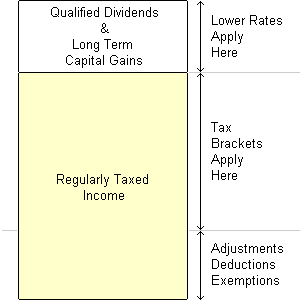Federal Tax Brackets
Your tax bracket is the rate you pay on the "last dollar" you earn; but as a percentage of your income, your tax rate is generally less than that.
First, here are the tax rates and the income ranges where they apply:
To take an example, suppose your taxable income (after deductions and exemptions) is exactly $100,000 in 2012 and your status is Married filing jointly; then your tax would be calculated like this:
| ( | $ 17,400 minus | 0 ) | x .10 : | $ 1,740.00 |
| ( | 70,700 minus | 17,400 ) | x .15 : | 7,995.00 |
| ( | 100,000 minus | 70,700 ) | x .25 : | 7,325.00 |
| Total: | $ 17,060.00 |
This puts you in the 25% tax bracket, since that's the highest rate applied to any of your income; but as a percentage of the whole $100,000, your tax is about 17%.
This next calculator lets you try it out with your own numbers:
Where Tax Brackets Apply
|
"Taxable Income" above is really Regularly Taxed Income minus Adjustments, Deductions, and Exemptions.
Payroll Tax (Social Security and Medicare), and
Qualified Dividends and Long Term Capital Gains are separate calculations.
(See this Tax Calculator for more.)
The obvious way to lower your tax bill is to increase the untaxed area at the bottom of the diagram.
Contributions to deductible retirement accounts count as adjustments;
mortgage interest and contributions to charity count as deductions.
|
|

|
Tax Hikes, Tax Cuts
1993 saw a tax hike on the wealthy (via two new brackets at the top), and then
2001 through 2003 saw a series of tax cuts that lowered the tax brackets as follows:
| 1992 | 1993 -
2000 | 2001 | 2002 | 2003 -
2012 | 2013 -
2017 | 2018 -
2026 |
| 15% | 15% | 15% | 10% | 10% | 10% | 10% |
| 15% | 15% | 15% | 12% |
| 28% | 28% | 27.5% | 27% | 25% | 25% | 22% |
| 31% | 31% | 30.5% | 30% | 28% | 28% | 24% |
| 36% | 35.5% | 35% | 33% | 33% | 32% |
| 39.6% | 39.1% | 38.6% | 35% | 35% | 35% |
| 39.6% | 37% |
|
From 2000 to 2002 most brackets dropped by one percent, and there was a new low bracket added at the very bottom.
In 2003 most brackets got an additional cut of two percent with a 3.6 percent cut at the top.
(But note that the rich still paid more in 2003, and everybody else paid less, than was the case in 1992.)
In 2013, the 2003-2012 rates were extended for everyone except singles making over $400K and couples making over $450K.
2018 saw cuts across the board.
|